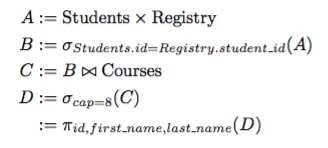For each of the following, indicate whether the statement is true, false, or unspecified according to the UU schema. Explain why, but keep your explanations very brief. (For example, you might write, “True because of the foreign key constraint between blah and blah.”)
Different students may have the same first and last name.
Every student must have a don.
Students can have more than one don.
No two members of the faculty can have the same last name, even if they have different first names.
Sometimes two or more professors may share the same phone number.
Professors may teach more than one course, though some slackers may not teach any.
Some courses taught in different departments may have the same title.
No two distinct courses taught by the same professor may have the same title.
Write SQL queries to answer the following questions. (Just write the SQL, do not include the results that the the given query would return for a snapshot of the UU database. I have provided a partial example of results to help clarify what is being asked.)
What courses are being offered by instructors who are also dons?
title teacher ----------- ----------- Cyberpunk Siff ...What are the id numbers of students who have the same last name as their don?
id -- 5 ...How many students are signed up for both math and lit courses? Solve two different ways: one without subqueries, one with subqueries.
COUNT(*) -------- ...What are the identification numbers of students who either have the first name Ada or are registered for a class that allows the enrollment to exceed 100?
id -- 2 ...
Write SQL queries that correspond to the following descriptions. (Again, just write the SQL, do not include the results that the the given query would return for a snapshot of the UU database. I have provided a partial example of results to help clarify what is being asked.)
List the first names of pairs of students who have the same last name, but different first names.
first_name first_name ---------- ---------- Dot Nancy ...List the first and last names of instructors who are dons but are not teaching any courses. The list should be in order of first name (with ties broken by last name).
first_name last_name ---------- --------- Abby Straction ...List the first and last names of students who have the same first name as an instructor for at least one of the courses for which they have registered.
first_name last_name ---------- --------- Dan Data ...For each student enrolled in at least one course, list their first and last names, ID#s, and the number of courses (
n) for which they are enrolled in descending order of the the number of courses with ties broken by increasing ID#.first_name last_name id n ---------- ----------- -- - ...List, in alphabetical order without duplicates, the last names of teachers such that the maximum capacity of one (or more) of their courses is at least twice that of another of their courses.
teacher ------- ...Find the most common first name among all students and faculty. Include ties, that is, if Jim and Mike are tied as the most common names, list both, in alphabetical order.
first_name ---------- ...
Consider this sequence of relational algebra expressions:

Translate it into a single equivalent SQL query. (Your translation should not be too literal, but it should capture the same meaning.)
In a clear and concise sentence, explain what the query achieves. (For example, “It finds all the professors who teach cosmology courses.” Example of what not to write: “It selects the foo attributes from the bar and buzz tables.”)
Consider this SQL query:
SELECT id, first_name, last_name
FROM Students NATURAL JOIN Registry NATURAL JOIN Professors
WHERE department = 'econ'Explain what you think is the intended goal of the query, why the query will fail to achieve that goal, and offer an SQL query that will achieve that goal.
In a clear and concise sentence, explain what the following query achieves:
SELECT first_name, last_name
FROM Students
WHERE (SELECT COUNT(*)
FROM Registry
WHERE student_id = id) IN
(SELECT MAX(Temp.n)
FROM (SELECT student_id, COUNT(*) AS n
FROM Registry
GROUP BY student_id) AS Temp)Write and SQL query to compute the average capacity of a UU course, assuming that the capacity is 15 if it is not explicitly specified in the database.
Read about SQL conditional
expressions and the CASE operator. Given what you
learn, rewrite your solution to the previous problem more
compactly.